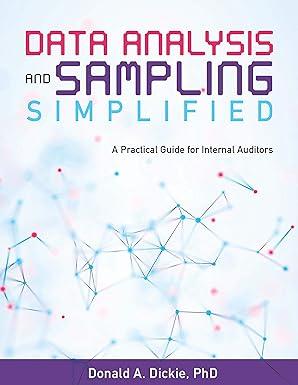Question
The problems in Chegg Study for this textbook do not answer these questions... 9-42. Smith, Inc. Rachel Robertson wishes to use mean-per-unit sampling to evaluate
The problems in Chegg Study for this textbook do not answer these questions...
9-42. Smith, Inc.
Rachel Robertson wishes to use mean-per-unit sampling to evaluate the reasonableness of the book value of the accounts receivable of Smith, Inc. Smith has 10,000 receivable accounts with a total book value of $1,500,000. Robertson estimates the populations standard deviation to be equal to $25. After examining the overall audit plan, the auditors believe that the accounts tolerable misstatement is $60,000, and that a risk of incorrect rejection of 5 percent and a risk of incorrect acceptance of 10 percent are appropriate.
Required:
a. Calculate the required sample size.
b. Assuming the following results:
Book value of items in sample = $149
Average audited value of items in sample = $146
Standard deviation of sample = $28
use the mean-per-unit method to:
(1) Calculate the point estimate of the accounts audited value.
(2) Calculate the projected misstatement for the population.
(3) Calculate the adjusted allowance for sampling risk.
(4) State the auditors conclusion in this situation (accept or reject).
Use the following replies for the above questionsreplies may be used once, more than once, or not at all. In all cases, select the reply closest to your answer.
|
| Replies |
| Sample size (a)
Other replies for (b)
|
|
9-43. Smith Company: Ratio and Difference Estimation
Note: This problem uses the information presented in the previous question and extends the analysis to ratio and difference estimation.
Use the replies presented in the preceding problem for this problem.
a. Use the ratio method to calculate:
(1) Projected misstatement.
(2) Estimated total audited value.
b. Use the difference estimation method to calculate:
(1) Projected misstatement.
(2) Estimated total audited value
Step by Step Solution
There are 3 Steps involved in it
Step: 1

Get Instant Access to Expert-Tailored Solutions
See step-by-step solutions with expert insights and AI powered tools for academic success
Step: 2

Step: 3

Ace Your Homework with AI
Get the answers you need in no time with our AI-driven, step-by-step assistance
Get Started


